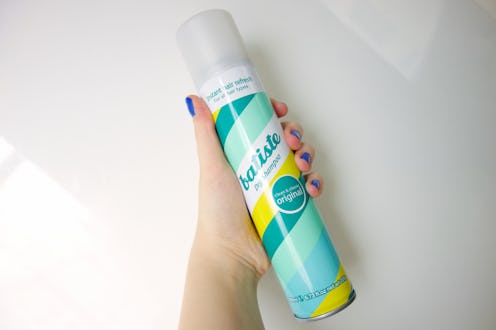Fashion
How to Finally Master Dry Shampoo

Dry shampoo is one of those things that — once put into action — usually inspires a love-affair domino effect. It goes a little something like this. The miracle spray/powder soaks up excess second-day hair oiliness. You see immediate results; all of a sudden, you get it. Then, you learn about its ability to make your hair look incredibly voluminous, so you rave about it to all your friends. They buy it, and the cycle continues. The beauty world's version of the circle of life, if you will.
Sure, dry shampoo may not be the newest beauty product on the block (as in, it's been around since forever, at least in basic cornstarch powder form), but oddly enough, its popularity hasn't kept it from falling into the "sort of misunderstood" category either. Personally, I think dry shampoo is underrated as a multi-use hair tool, and a lot of the time, consumers aren't investing in the right brands, especially ones that actually mesh well with one's hair color and texture. I promise you there are sprays that won't leave you with dull, heavy-feeling, white powder-y residue-laden strands. And to make good on that promise, here's what you need to know about the best dry shampoos on the market right now.
What's Awesome About Dry Shampoo
- The most obvious of the benefits: it staves off oily second-day hair beautifully.
- It can save you in a pinch. Perhaps you were planning on washing your hair this morning, but you overslept. Quick solution, two words: dry shampoo.
- You can keep that fabulous blowout a little longer, maybe even by a day or two, if you play your dry shampoo cards right.
- Depending on the brand, it's a lot cheaper than texturizing sprays, and guess what? It basically does the same thing.
- When sprayed sparingly on the roots (and mussed up accordingly), you'll be left with thicker, more voluminous hair. Seriously.
- It's great for giving just the right amount of texture to a messy bun or a little more "bulk" to a ponytail or braid.
- It helps bobby pins grip onto hair... and stay there.
What You Should — and Shouldn't — Be Doing
- DO. Spray directly onto your roots, but do so from at least six inches away.
- DON'T. Key word "dry." As in, don't use dry shampoo on damp or wet hair.
- DO. Focus on smaller areas by sectioning them off. That way, you're evenly distributing the dry shampoo. If you apply too much to one area, expect it to look oily within a few hours.
- DO. Let the shampoo set for a couple of minutes before brushing/tousling it out.
- DON'T. This isn't a cure-all for never washing your hair. So, I'm going to assume that you do, in fact, enjoy washing your hair and this is just part of the whole "not washing it as much" thing.
- DO. Make your blowout last by preemptively spraying a light coat at your roots before said blowout. That way, the oil-soaking goodness is already in place and ready to fight the good fight.
- DO. Pretend like you're in a hair commercial. Flip your head upside down, brush your hair out at this angle, or just comb through with your fingers.
- DO. For fine or limp hair, back comb your hair gently after spraying in.
- DON'T. A little goes a long way — don't overdo it even if you tend to have oilier second-day hair.
- DO. In order for dry shampoo to do its thing properly, try to wean off of washing your hair with real shampoo everyday.
And the Best Dry Shampoo Award Goes to...
- All-Around Winner: Klorane Gentle Dry Shampoo With Oat Milk ($18)
- Kind of Feels Like You Washed Your Hair: Serge Normant Meta Revive Dry Shampoo ($25)
- Budget Find: Suave Professionals Dry Shampoo Spray ($3)
- For Dark Hair: Bumble and bumble. Brown Hair Powder ($35)
- For Light Hair: Oscar Blandi Pronto Dry Shampoo Powder ($21)
- For Color-Treated Hair: Aveeno Pure Renewal Dry Shampoo ($9)
- Not Actually Dry Shampoo But Works Just Like One: Oribe Dry Texturizing Spray ($39)
- Honorable Mentions (at Every Price Point): Lush No Drought ($14); Psssssst! Instant Spray Shampoo ($9); Göt2b Rockin' It Dry Shampoo ($7); Rene Futerer Naturia Dry Shampoo ($13)
Image: Idhren/Flickr; Maegan Tintari/Flickr; Klorane